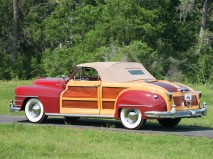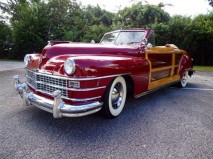1947 Chrysler Town and Country Convertible
The number of cars produced - 3316 pcs.
Engine - In line 8-cylinder
Engine power - 135 hp
Engine capacity - 323.5 cu. inches
Speed - 120 km / h
The Chrysler Town & Country is perhaps the best-known of all woodies. With a limited production run and a top-of-the-line reputation, their recent addition to the CCCA's list of Full Classics has made them some of the most sought-after post-war convertibles. Only 8368 were built between 1946 and 1948, making them quite rare, and the wood bodies have only served to further cull their numbers, with some sources suggesting that fewer than 200 1948 models still exist.
Although Chrysler had plenty of experience building its prewar Town & Country wagons, it had to learn anew about building the 1946, 1947, and 1948 T&C convertibles. The ragtop's structure was entirely different from that of other Chrysler models, and there was the added problem of no steel top to provide the desired torsional strength. After considerable trial and error, engineers devised a conventional cowl and floor section for the woody convertible, with a surrounding steel beltline and the rear fenders tied together by a steel shelf. The B-pillars were wood, supported at their bases by tunnels that stretched across the floor pan to meet upright angle iron supports. Sheet metal carried the winding mechanisms for the rear side windows, which helped remove stress from the wood rear-quarter body areas. The doors were mainly solid wood, too, and because of their weight, a sheet metal leading edge was attached to support their hinges. As in the rear quarters, sheet metal housed the window regulators.
This complex construction did not lend itself to conveyor-type assembly methods, and extensive use of welding machines was out of the question. Accordingly, the metal components were filed and welded by hand, and wood sub-assemblies were each put together by one or two workers using crafts more appropriate for a boatyard than a car plant.
Ply-metal panels were installed in the ash framing by means of a hammer, wedges, glue, and rope caulk. Teams moved from one body to the next, each handling a specific task. To say the Town & Country involved a lot of time-consuming hand labor is an understatement. For example, it took 12 workers just to install each convertible top. Once the body was completed, it was mated to its chassis in the usual manner. Assembly then proceeded from station to station, much like that of the conventional models. Compared to the normal production-line cars, T&Cs moved at a snail's pace, which accounts for both their low volume and high price. Production from 1946 through 1948 averaged only 10 units per day, and it took fully three eight-hour shifts to achieve that.
But the slow going produced amazing results, and materials were the very best. The white ash, for example, was not only more durable than most woods but was also unequaled for the beauty of its grain, which contrasted perfectly with the mahogany insert panels.
Also, the framework was not made of a single piece of wood, so it was possible to match grain patterns exactly. The individual pieces were carefully selected and matched and were then laminated into the larger sections that made up the entire framework. It all added to the cost, but you couldn't find a more carefully or better built car for the money than the classic Town & Country.
Prices have skyrocketed on high-quality Town & Country convertibles following the CCCA announcement, and these cars rightly deserve their place on the roster. With impressive power and performance and that timeless wooden body, they are exactly the kind of hand-crafted rolling works of art the CCCA was founded to celebrate.













